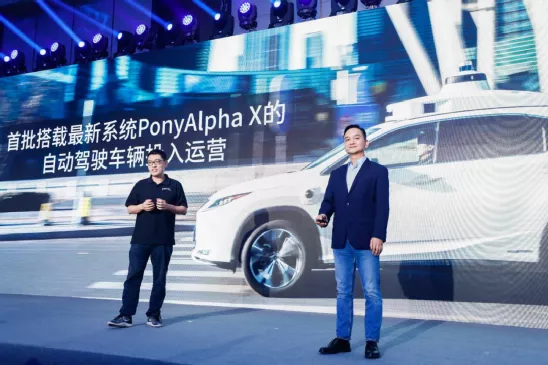Media Under the “Carrying 100 People” focuses on the evolution of the automotive industry chain
By Zhou Changxian
On May 13th, autonomous driving company Pony.ai held a press conference in Beijing and announced two things.
Firstly, Pony.ai will further expand the scale of its autonomous driving service (Robotaxi) and gradually increase its coverage to five major cities in China and the United States. Starting from now, Pony.ai’s Robotaxi service in Beijing’s Yizhuang will expand open to the public, and the next step is to fully launch in Shanghai.
Secondly, Pony.ai will join hands with China’s leading travel companies, Hongqi Zhixing and T3 Travel, to jointly promote the further expansion and upgrading of Robotaxi services.
Compared with many startups, Pony.ai’s press conference was more exciting, with both bitter and sweet memories, the vast universe, and a hint of a gunpowder flavor in the air.
Robotaxi Leads, Both Commercial and Passenger Vehicles Thrive
Pony.ai was established at the end of 2016 by two PhDs, Peng Jun and Lou Tiancheng, and was the first company in the world to launch autonomous driving services (Robotaxi) in both China and the United States.
Before founding Pony.ai, Peng Jun served as the chief architect of Baidu’s autonomous driving department, responsible for the overall strategic planning and technology development of Baidu’s autonomous driving.
Lou Tiancheng, known as a master, is a world-renowned computer programming genius. He won the TopCoder China Championship for 11 consecutive years and won the Google Global Programming Challenge twice. He has worked on autonomous vehicle technology development at Google X (Waymo) and is also the youngest T10 engineer in Baidu’s history.
In the first half of the press conference, Pony.ai CEO Peng Jun and CTO Lou Tiancheng took the stage together and introduced Pony.ai’s entrepreneurial process, strategic planning, and the progress of its main businesses.
Peng Jun was dressed elegantly and skillfully, wearing a casual suit on the upper body and white jeans on the lower body, and the black leather shoes were shiny. Lou Tiancheng, on the other hand, was dressed casually in a cultural shirt with the company logo, baggy jeans, and loose Nike shoelaces on his left foot.
They first showed Pony.ai’s first “vehicle” – a small CART that carried a complete set of perception, calculation, and other hardware and completed Pony.ai’s earliest testing and data acquisition in China.
Now, Pony.ai’s hardware system has been iterated to the fifth generation – PonyAlpha X, whose perception hardware includes:
4 LiDARs, 2 of which are located on the roof of the car, and the other 2 are located on the left and right sides of the front of the car respectively for blind area detection.
4 millimeter wave radars with a detection range of 200 meters. Two are forward-facing, one is located on the left side of the roof of the car for quick detection of left side traffic during right turns, and one is rearward-facing.
4 wide-angle cameras covering the area within 80 meters around the car.### 3 Cameras:
- 1 forward-facing long-range camera with 200m range
- 1 forward-facing mid-range camera with 150m range
- 1 camera covering a 180m forward-facing area
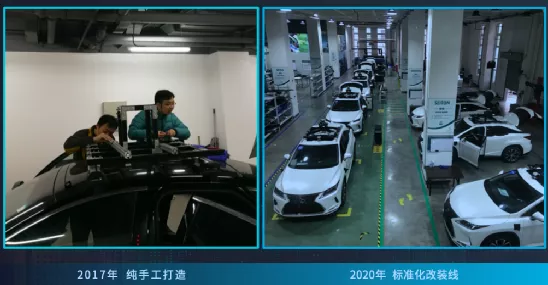
Today, the self-driving vehicles of Pony.ai are no longer handcrafted. In November 2020, Pony.ai built a standardized production line for modifying vehicles. In February of this year, vehicles equipped with PonyAlpha X began to be mass-produced.
In addition to the PonyAlpha X onboard hardware system, Pony.ai has also developed a series of productized systems, including the onboard operating system PonyBrain, the vehicle-side human-machine interaction system PonyHI, and the self-driving fleet management platform.
According to Moru Yi, vice president of Pony.ai and the person in charge of Robotaxi, the self-driving fleet management platform includes: system production automation, system software and hardware version management, real-time vehicle information sharing, travel service management, and user experience management.
At the OEM level, Pony.ai has established cooperation with leading international and domestic automakers such as Toyota, Hyundai, FAW, and GAC. Its software and hardware technology is adapted to a variety of power forms including fuel, electric, and hybrid on vehicle models such as Toyota RX, Lincoln MKZ, BYD Qin, GAC Aion, and Hyundai Kona.
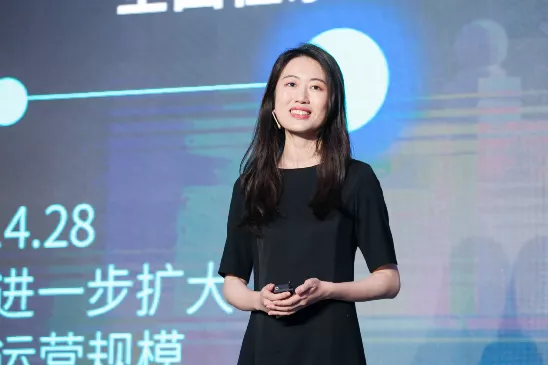
In 2018, Pony.ai signed a strategic cooperation agreement with GAC Group, and in November 2019, the two sides jointly established Guangdong Intelligent Networked Automotive Innovation Center Co., Ltd., actively promoting the commercial landing of Robotaxi in the Guangdong-Hong Kong-Macao Greater Bay Area.
Regarding cooperation with automakers, James Peng stated that it was not only at the technical level but also at a deep level.
“Deep cooperation is by no means the process of defining goals and interfaces and then doing their own things. Engineers from both sides can sit together, jointly identify and analyze problems, and jointly think, learn, and solve problems. Software and hardware must be integrated to provide consumers with the best experience.”
While actively expanding its own self-driving fleet, Pony.ai’s self-driving fleet management platform also supports deep integration with third-party platforms. For example, the self-driving travel service launched by Pony.ai in Irvine, California in the United States has a deep cooperation with Via, the third-largest travel service provider in the United States.
In China, Pony.ai has reached strategic cooperation with service platforms such as UCar, Hongqi Zhihang, and T3 Travel, respectively promoting operations in the Guangzhou-Shenzhen, Beijing, and Yangtze River Delta regions.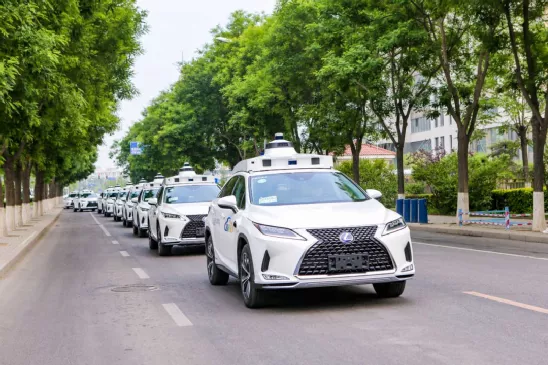
“To build a future travel ecosystem, it requires a lot of partners to work together,” said Peng Jun. “With ‘virtual driver’ technology at the core, we will strengthen cooperation with vehicle manufacturing companies to create truly convenient future travel tools. We will also cooperate with travel platforms to create the best travel services and ultimately bring high-quality travel experiences to users.”
In addition to its Robotaxi business line, in April 2019, Pony.ai announced its layout in the field of autonomous driving long-haul freight transportation. Its truck business line Robotruck (Zhi Ka) has now entered the large-scale testing phase.
According to Frank Pan, the person in charge of Robotruck, Zhi Ka’s sensor configuration includes: 2 LiDARs with a visible distance of 150 meters, 1 forward-facing millimeter-wave radar with a visible distance of 200 meters, 1 wide-angle camera with a visible distance of 200 meters, and 1 long-distance binocular camera with a visible distance of 300 meters+. There are also rear cameras and millimeter-wave radars, both with a visible distance of 200 meters.
He believes that a wider camera coverage can achieve better object detection and classification, and long-range cameras and millimeter-wave radars can better detect high-speed vehicles, while rear cameras and millimeter-wave radars can better change lanes when traveling at high speeds.
On April 21st, Guangzhou Pony.ai Smart Logistics Technology, a wholly-owned subsidiary of Pony.ai, obtained a road transport permit for cargo transportation issued by Guangzhou Nansha.
Currently, Pony.ai has four vehicle platforms for Zhi Ka and two commercial operating partners. It is said that in the commercial testing and operation with partners in Nansha, more than 100 cargo shipments have been completed.
Autonomous Driving Enters the “Second Half”
On April 28th, Pony.ai announced a full upgrade of its Robotaxi service PonyPilot+, with its latest generation of autonomous driving vehicles joining the Robotaxi operating fleet to provide services to the public.
On May 13th, following the Baidu Apollo unmanned driving Robotaxi officially launching commercial operations, Pony.ai announced that it would be the first to fully open and expand the travel service range of autonomous driving Robotaxi in Beijing Economic and Technological Development Zone’s high-level automatic driving demonstration zone.
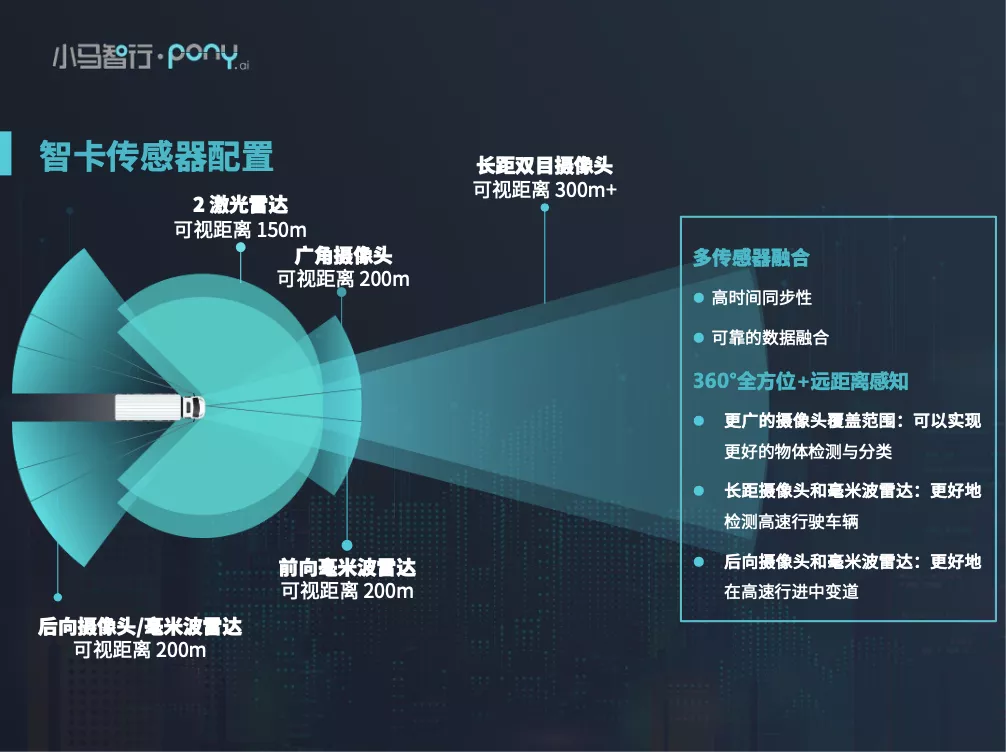 The Robotaxi service range of Pony.ai will cover a core operating area of 150 square kilometers in Beijing Economic-Technological Development Area (Yizhuang New Town), which includes approximately 150 stations covering different scenes such as subway stations, parks, communities, sports centers, and key commercial areas. The service hours are from 8:30 am to 10:30 pm, covering morning and evening rush hours, as well as nighttime periods.
The Robotaxi service range of Pony.ai will cover a core operating area of 150 square kilometers in Beijing Economic-Technological Development Area (Yizhuang New Town), which includes approximately 150 stations covering different scenes such as subway stations, parks, communities, sports centers, and key commercial areas. The service hours are from 8:30 am to 10:30 pm, covering morning and evening rush hours, as well as nighttime periods.
So far, Pony.ai has provided Robotaxi services in five cities including Nansha in Guangzhou, Irvine and Fremont in California, as well as Yizhuang in Beijing, and will open in Shanghai this year.
“We are gradually expanding the scale of operations in five cities, and have the opportunity to learn about different road conditions in different regions to verify the reliability of our technology. It is important to ensure the effective use of resources, and the ‘quantity’ and ‘quality’ of data are equally important,” said James Peng.
According to Zhang Ning, head of Pony.ai’s Beijing R&D Center, policies have made it possible for autonomous driving to open up. This also indicates that Pony.ai is no longer just testing, but has truly entered the demonstration area and is operating on a large scale.
Earlier, in an interview with Forbes, Peng Jun also agreed with this view, stating that the first stage of autonomous driving was to build mature technology, products, and experience to prove the feasibility of the technology. In the second stage, in addition to commercialization, it is more important to truly “scale up” from research and development to large-scale production, he said.
As a leading start-up in the autonomous driving field, although Pony.ai has adopted a dual path of commercial and passenger vehicles, profitability is still distant. The industry also has doubts about independent autonomous driving companies and their Robotaxi business.
In late March of this year, He XPeng, founder of XPeng Motors, asserted that pure autonomous driving software companies would face the challenge of how to transform and integrate within three years. “Software with data, hardware with experience and services with operations must be closed-loop integrated, otherwise it will be extremely difficult,” he said.
Previously, Su Jing, head of Huawei’s ADS, said in an interview with the media that he would rather die than do Robotaxi, because Robotaxi is a result, not a commercial goal.
“I’m someone who makes passenger cars. That market will definitely be mine, but not now,” he said.# On the View of Smart Driving and Production
In the view of Lou Tiancheng, different expertise is needed for smart driving and production, and compared with automakers or other tech companies, everyone has their own strengths, just like a swimmer may not necessarily run fast.
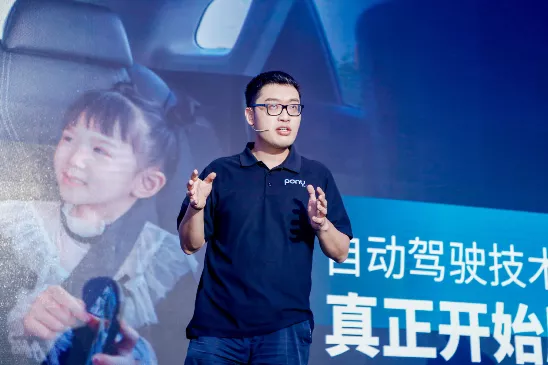
“Smart driving is a complex system engineering, which cannot be accomplished by recruiting some software engineers or AI experts. Building safe technology requires a lot of data accumulation, scenario development and software-hardware collaboration. Many automakers hope to have this ability. Whether they can achieve it or not is another matter.”
Although the industry has different views on companies like Pony.ai, it does not affect the capital’s optimism and investment.
In February 2021, Pony.ai announced a C+ round of $100 million, bringing the total financing to more than $1.1 billion and the valuation to over $5.3 billion, making it one of the world’s most valuable autonomous driving companies. A year ago, Pony.ai completed a $462 million B round of financing, including Toyota’s $400 million strategic investment. Currently, Pony.ai’s investors also include Sequoia Capital, IDG Capital, Morningstar Ventures, and Junlian Capital.
“Compared to a few years ago, the availability and commercial development of smart driving technology have far exceeded expectations.” In the salon session of the press conference, Yang Di, the managing director of CPE CITIC Industrial Fund, a Pony.ai investor, said.
Regarding the commercial logic of Pony.ai’s businesses for both passenger and freight transportation, Peng Jun said, “Adopting such a dual-line business development is because we have observed that the ability and technology of virtual drivers are interconnected in the two largest markets in the transportation industry. Many of the difficulties in technology research and development are the same, but they also bring many opportunities.”
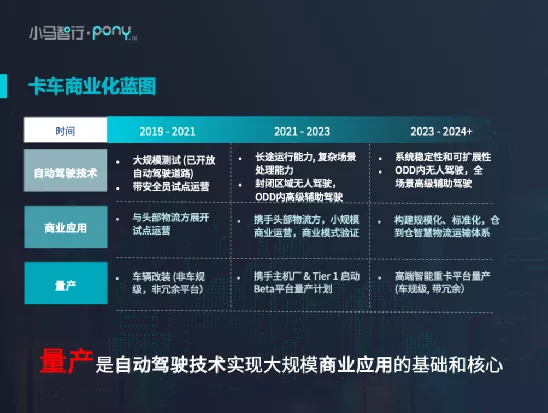
For example, in the trucking business, Pony.ai needs to monitor longer distances, which requires accurate grasp of the movement trajectory and model of large vehicles. These accumulations and experiences can also benefit passenger cars. At the technical level, the return on investment (ROI) is also high.
However, he made it clear that “it is currently impossible to judge which route can achieve commercialization earlier, so we are balanced in investment for these two businesses.”
“The reason why people’s demand for smart driving is not so strong today is because the technology of smart driving still needs further polishing.”
Like Lou Tiancheng, Peng Jun’s ability to make comparisons is also exquisite.
“If the clock rewinds to 2004, people would not believe that they would spend five or six hours staring at a mobile phone screen every day. User needs are always stimulated with the development of technology. We cannot predict the future with today’s behavior and ideas.”
This article is a translation by ChatGPT of a Chinese report from 42HOW. If you have any questions about it, please email bd@42how.com.
